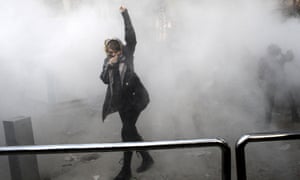
Iran’s supreme leader has blamed the Islamic Republic’s enemies for nationwide unrest, as authorities cracked down with increasing intensity on protesters, leading to nine deaths overnight.
“In the events of the past few days, the enemies of Iran are deploying every means at their disposal including money, arms and political and intelligence support to coordinate making troubles for the Islamic establishment,” Ayatollah Ali Khamenei said in his first comments since the protests began on Thursday. “The enemy is always looking for an opportunity and any service to infiltrate and strike the Iranian nation.”
Videos posted on social networks suggested that both riot police and the protesters are becoming more confrontational. In a sign that the rhetoric is also hardening, Esmail Kowsari, a senior revolutionary guards commander, vowed that the elite forces would crush those he said were disturbing the security.
In the event the unrest continues, “the authorities will undoubtedly make a decision and finish the business”, Kowsari said.
Another senior official directly blamed Saudi Arabia, Iran’s regional rival, for the growing unrest in Iran. Ali Shamkhani, the secretary of Iran’s supreme national security council, told a Lebanese Arabic-language TV channel that the number of messages posted on social networks sent online via Saudi Arabia showed they were involved and warned that Iran would retaliate with “an appropriate response” in due course.
“Iranian people are sensitive about any meddling done by the Saudis even to a greater extent than they are sensitive towards the US meddling,” Shamkhani told Al-Mayadeen, which is sympathetic to the the Lebanese Hezbollah militia.
The protest began on Thursday when opponents of Iran’s moderate president Hassan Rouhani, gathered in north-eastern Iran to complain about economic grievances. They then spread nationwide and took on more of an anti-regime dimension, including anti-Khamenei chants. An intervention byRouhani on Sunday, when he acknowledged discontent, has failed to quell the anger.
At least 21 people are now estimated to have died in the protests which are the biggest since unrest in 2009 unrest. The geographical scale of the protests has rarely been seen since the 1979 Islamic revolution. At least 450 people have been arrested in Tehran alone since Saturday – nationwide figures have not been released.
State TV and semi-official new agencies that used relatively conciliatory language last week are increasingly referring to the protesters as mobs who want to destroy public property. On Tuesday judicial authorities gave an ultimatum to protesters, threatening harsher sentences in the unrest continues.
State television said six protesters were killed overnight as they tried to attack a police station in the town of Qahderijan in the central Isfahan region. It also said an 11-year-old boy and a 20-year-old man were killed in the town of Khomeinishahr, while a member of Iran’s paramilitary Revolutionary Guard was killed in the town of Najafabad. None of the reports could be confirmed independently.
Observers reported riot police riding on motorbikes and wielding batons on the streets of Tehran. Similar scenes were reported in other cities.
A Tehrani man who drives a taxi for Snapp – Iran’s equivalent of Uber - told the Guardian that security guards riding on motorbikes and wielding batons were out in full force in Tehran on Monday night.
“I was out at 8 or 9pm, and the atmosphere was tense. In Tehran the riot police was unleashed near Vanak square, in Enghelab street, and in Naziabad,” he said. “I was in Vanak Sq at 5pm and it was full of security guards.”
The driver said the protests are more widespread in the provinces than in Tehran because working class people in the provinces are the most affected by Iran’s economic problems.
“In Kermanshah [west of Iran] there was an earthquake recently and a lot of those affected are still living outside,” he said. “In Ahwaz, 30 years after the [Iran-Iraq] war, the situation in still bad.”
“The city of Arak has many industries and a lot of people are without jobs. One of my relatives work for petrochemical company in Arak, they haven’t got salaries for a few months now, that’s why they’re out.”
“Gradually people are getting fed up and raising their voice.”
A student of Tehran University, who spent Monday night in the campus, said people were worried. “They don’t know how this is going to unfold, no one knows how this is going to pan out - they are perplexed because it is happening in provinces.”
Rouhani spoke with a number of parliamentarians on Monday in a meeting that officials insisted was planned before the protests began. The president acknowledged anger over the country’s flagging economy, though he and others warned that the government would not hesitate to crack down on those it considered lawbreakers.
The scale and the speed at which the protests have spread across Iran has puzzled many in the country, including reformists who are critical of the political atmosphere but are wary of any move towards regime change.
Iran blocked access to social networks including Telegram and Instagram on Sunday, but insisted the move was temporary.
One of Iran’s most outspoken MPs, Mahmoud Sadeghi, said on Twitter he had urged the interior ministry not to link the protests with foreign powers and instead improve the economic situation, open up the state television to diverse opinions and lift restrictions on regime critics.
A spokeswoman for the EU foreign policy chief, Federica Mogherini, said the EU had been touch with authorities in Iran. “We expect that the right to peaceful demonstration and freedom of expression will be guaranteed,” she said.
No comments:
Post a Comment